 |
| Piping Hot Water |
Latest news and my views about the suggestion on developing the hot spring (9)
Whenever I hear of development, my mind reminds me of how fast Singapore is to making changes to things and how often it is for economic reasons. So when news came up about developing the Sembawang Hot Springs on April 18 2016, I really will like to ask for the government to not develop the place into a paid theme park or spa. The hot spring should be treated like any public park; free for public use.
I agree with Sembawang's Minister of Parliament (MP), Mr Ong Ye Kung, where he opined that the hot spring should not be commercialised. Fellow Sembawang MP Dr Lim Wee Kiak suggested that a shallow pool be built so that more people can enjoy the hot spring. I'd say, make it into a park that incorporate as much of its surrounding and nature as possible.
 |
| Beitou Public Library |
I remember walking along Taiwan's hot spring town - Xin Beitou. The municipal government took great care to ensure that structures built there were environmentally-friendly. Take the Beitou library for an example. The building built in 2006 using wood from managed forest. The inclusion of large windows into the building allows for natural light to be harnessed for its internal lighting. (10)
 |
| Lovely Beitou man-made river |
 |
| Taiwanese artist painting a portrait of the public library |
This will give the place a lovely, tranquil feel. The public can relax, do their little exercises and even sit down to do their painting.
I'm also glad that there's a caretaker to this hot spring. Previously when I was there, there were a few people who were washing their clothes using the spring water. It was not just one or two pieces, but bucket-loads. I suspect that these people were doing this for commercial gains. It's terrible as they used soap powder to wash those clothing and as the water goes back into the ground, I'm just concerned that the ground water would be polluted.
With a caretaker, I am sure that those few recalcitrant will be kept away.
Updated: April 18, 2016
Spring water in Singapore? How can this be? Singapore is not known for natural structures or formations.
Well, indeed we have a hot spring in our own backyard along Sembawang Road.
The hot spring was first discovered by property owner Mr Seah Eng Keong in 1909, it was the talk of town. (8) Mr Seah then set up a company called Singapore Hot Spring Limited that bottled the water under the name "Zombun". The water was tested to be alkali in nature and the water was "compared very favourably to the best spa waters in Europe". (3)
During the discovery of the hot spring, the water temperature was measured at about 70 degrees celsius. (6)
Fraser and Neave (F&N) with its monetary might then came in to buy over the land in 1921 and continued bottling the spring water under the brand names "Seletaris" and "Zom". (8)
In the 1923, a newspaper reporter encouraged the public to visit the Seletar Springs and as part of that visit, they could also look out for wild animals such as wild boars and possible tiger sightings in the jungles of Mandai. (1)
In 1933, F&N pumped in money to rebuilt the plant and "Singa Water" was born in 1935. These bottled water were then exported. (8) By 1940, a well had already been built over the hot spring. (2)
During the Japanese Occupation, the bottling of water continued but was disrupted in 1944 after the Allied Forces bombed that area. The spring did not start flowing again until 1964.
Interestingly, there used to be two separate springs in that same area - one that has hot water and the other, cold water. The villagers in the surrounding kampongs used the spring water to bathe, wash their clothes and even boiled eggs. (5)
My Experience at the Hot Spring
I never knew how hot Singapore spring water could be until I experienced it myself. There were pails that one can use. Bathtubs even, for those who want a soak of their feet. So since I'd made my way to the hot spring, there's no way that I'd not try out the water.
However, I was ill prepared. Those seasoned campaigners had brought along their own towels. Their towels would then be soaked in the hot spring water before they proceeded to wipe themselves from head to toe.
I managed to find a pail lying around, one of many pails. I filled the pail with about 1/4 of water and seeing that steam was rising from the water, I waited a bit. A few minutes later, I placed my hands above the water and it felt the tingly feeling. I then proceeded to sprinkle the water on my feet. It was HOT!
It was only after about 30 minutes that the heat from the sprinkled water was more bearable.
References
1. Seletar Springs. February 6, 1923. The Straits Times. P10.
2. "The Sorcerer" – First Full Rehearsal Of S.A.D.C. Opera. November 1, 1940. The Singapore Free Press and Mercantile Advertiser (1884-1942). P5.
3. Our aerated water trade. January 2, 1932. The Singapore Free Press and Mercantile Advertiser (1884-1942). P23.
4. Koh, B. S. March 15, 1989. Land near 'hot spring' site may be redeveloped. The Straits Times. P17.
5. The Singapore Free Press. March 7, 1960. Precious water runs to waste. P7.
6. The Straits Times. August 17, 1909. Untitled. P6.
7. The Straits Times. September 19, 1941. Advertisements Column 1. P5.
8. The Straits Times. March 10, 1967, SEMANGAT AYER LIMITED. P2.
9. Ong, J. April 18, 2016. Sembawang Hot Spring: Singapore's next theme park, spa or water-themed attraction. http://www.channelnewsasia.com/news/singapore/sembawang-hot-spring/2704714.html
10. Great Taipei Travel. Travel King. Accessed on: April 18, 2016. https://www.travelking.com.tw/eng/tourguide/taipei/taipei-public-library-beitou-branch.html
9. Ong, J. April 18, 2016. Sembawang Hot Spring: Singapore's next theme park, spa or water-themed attraction. http://www.channelnewsasia.com/news/singapore/sembawang-hot-spring/2704714.html
10. Great Taipei Travel. Travel King. Accessed on: April 18, 2016. https://www.travelking.com.tw/eng/tourguide/taipei/taipei-public-library-beitou-branch.html








